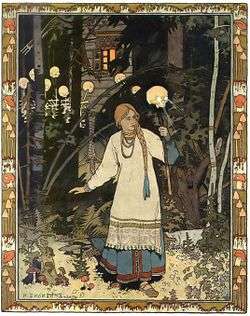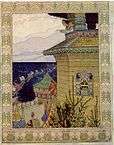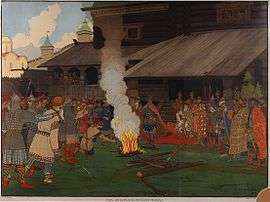Ivan Bilibin

.jpg)
Ivan Yakovlevich Bilibin (Russian: Ива́н Я́ковлевич Били́бин; 16 August [O.S. 4 August] 1876 – 7 February 1942) was a 20th-century illustrator and stage designer who took part in the Mir iskusstva, contributed to the Ballets Russes, became co-founder of the 'Soyuz russkih hudožnikov' '(Association of Russian Painters) and since 1937 a member of the Soyuz hudožnikov SSSR (Painters Association of the USSR). Throughout his career, he was inspired by Slavic folklore.[1]
Biography
Ivan Bilibin was born in Tarkhovka, a suburb of St. Petersburg. He studied in 1898 at Anton Ažbe Art School in Munich, then under Ilya Repin in St. Petersburg. After graduating in May 1900 he went to Munich, where he completed his training with the painter Anton Ažbe. In 1902–1904 Bilibin travelled in the Russian North, where he became fascinated with old wooden architecture and Russian folklore. He published his findings in the monograph Folk Arts of the Russian North in 1904. Another influence on his art was traditional Japanese prints.
After the formation of the artists' association Mir Iskusstva, where he was an active member, his entry into the newspaper and book graphics scene began with a commission for the design of magazine Mir Iskusstva in 1899. Artistic design of other magazines such as Dog Rose (Шиповник) and expenditure of the Moscow publishing house followed.
Bilibin gained renown in 1899, when he released his illustrations of Russian fairy tales. During the Russian Revolution of 1905, he drew revolutionary cartoons, especially for the magazine "Župel" (Жупелъ), which in 1906 became prohibited.
After the October Revolution in 1917, he left Russia.He was the designer for the 1909 première production of Nikolai Rimsky-Korsakov's The Golden Cockerel. The October Revolution, however, proved alien to him. In the period 1902 to 1904 he went to the ethnographic section of the museum of Alexander III to collect Ethnographic material and to photograph monuments of old village architecture in the Vologda, Archangelsk region, Tver; Skaja; olonezkaja and Petrozavodsk. After brief stints in Cairo and Alexandria, he settled in Paris in 1925. There he took to decorating private mansions and Orthodox churches. He still longed for his homeland and, after decorating the Soviet Embassy in 1936, he returned to Soviet Russia. He delivered lectures in the Soviet Academy of Arts until 1941. Bilibin died during the Siege of Leningrad and was buried in a collective grave.
Marital Life
In 1902 he Bilibin married his former student, the painter Marija Jakovlevna Tschembers (Мария Яковлевна Чемберс). They had two sons; Alexander (1903) and Ivan (1908). In 1912 he again married a former student, the art school graduate Renée Rudolfowna O'Konnel (Рене Рудольфовна О'Коннель). In 1923 he married the painter Alexandra Vasilyevna Schtschekatichina-Potozkaja (Александра Васильевна Щекатихина-Потоцкая), with whom he had a joint exhibition in Amsterdam in 1929.
Selected works
-
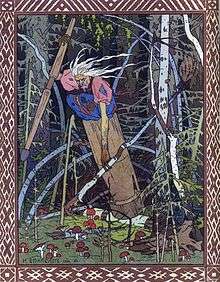
Baba Yaga from Vasilisa the Beautiful 1899
-
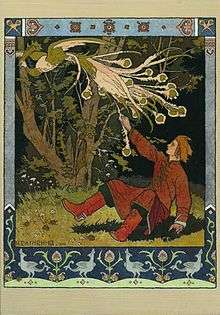
Ivan Tsarevich catching the Firebird's feather 1899
-
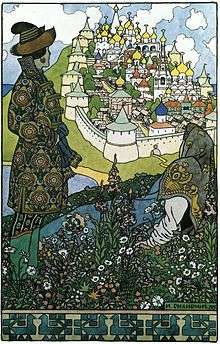
The Island of Buyan 1905
-
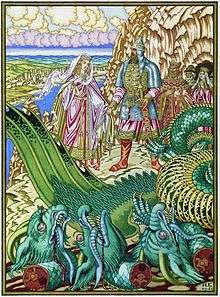
Dobrynya Nikitich rescues Zabava from the Gorynych
-

Tsar Dadon meets the Shemakha tsarevna (illustration to The Tale of the Little Golden Cockerel, 1906)
-
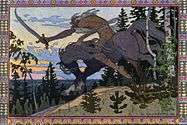
Koschei the Deathless from Marya Morevna 1900
References
- ↑ Vadeboncoeur Jr, Jim. "Ivan Bilibin". JVJ Publishing. Retrieved 14 March 2012.
External links
| Wikimedia Commons has media related to Ivan Bilibin. |
- Ivan Yakovlevich Bilibin at the Wayback Machine (archived December 2, 2005) at www.scumdog.demon.co.uk

